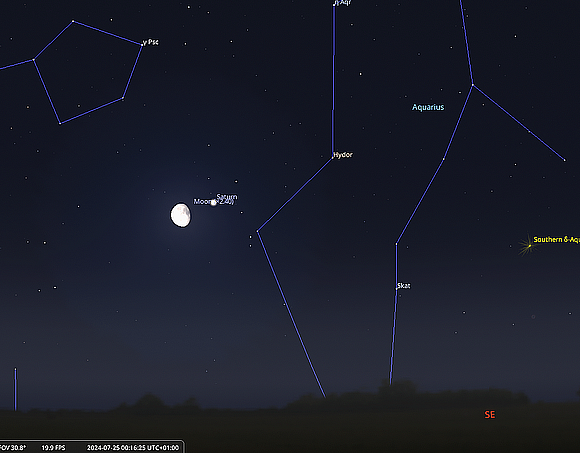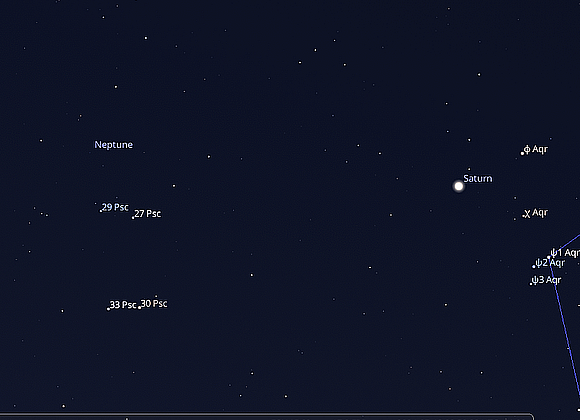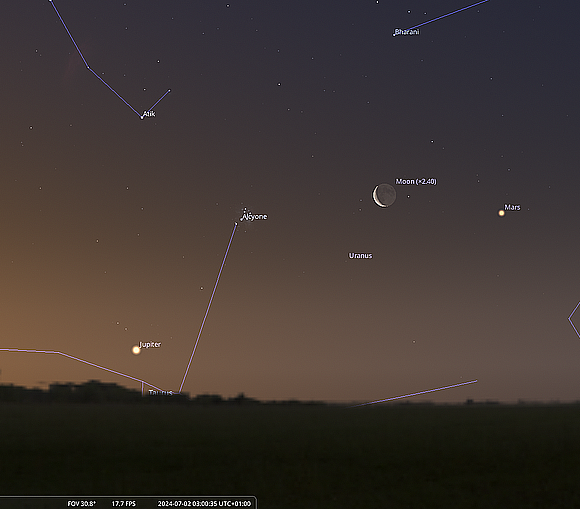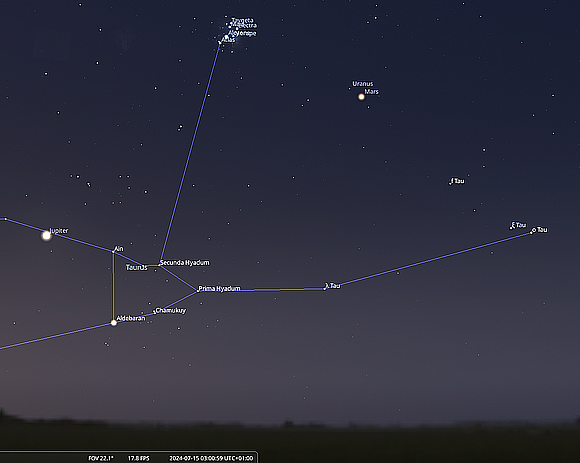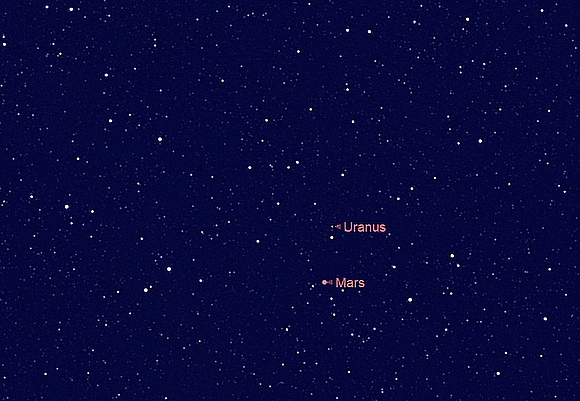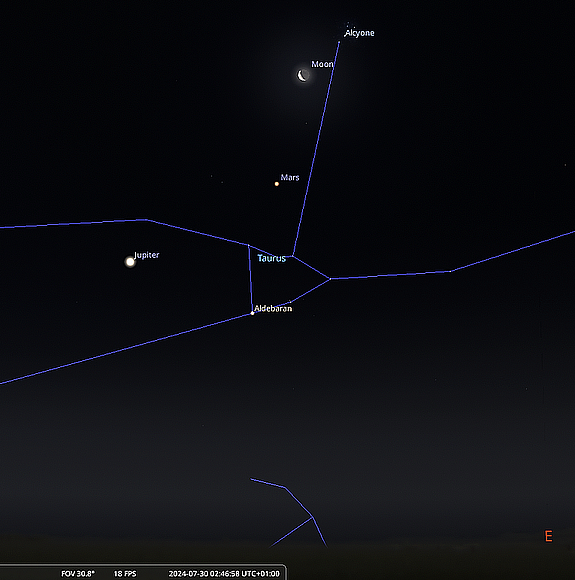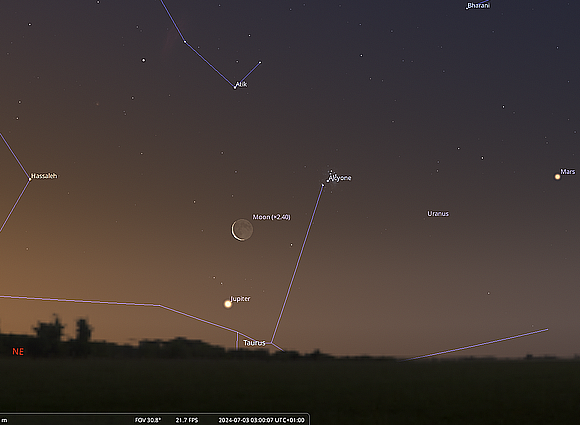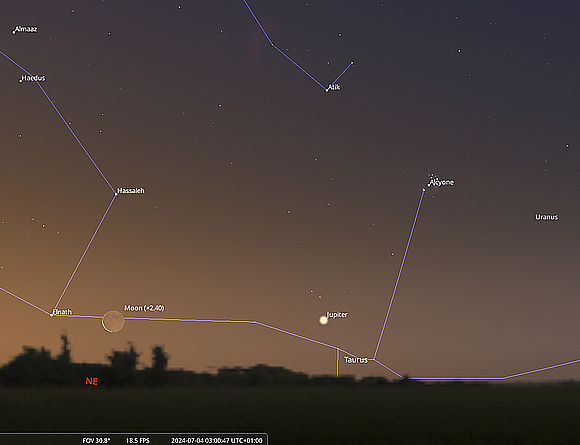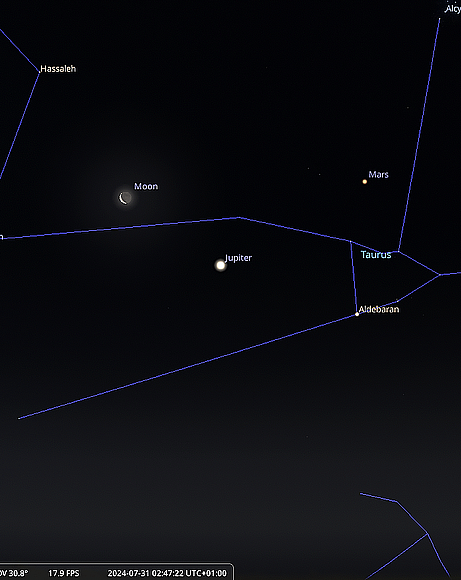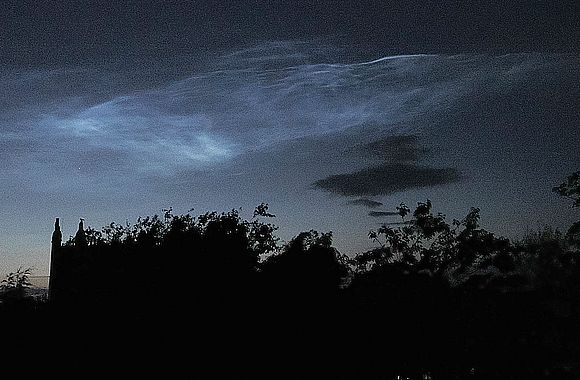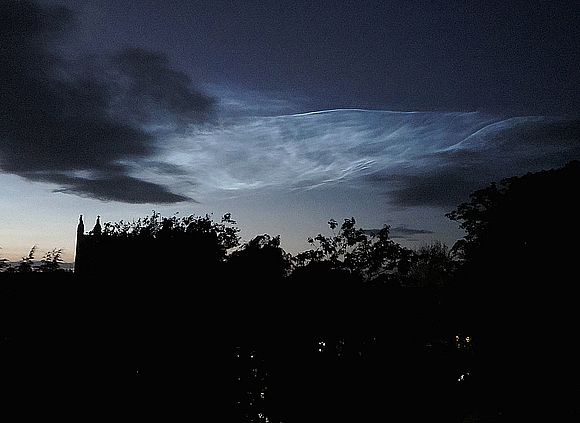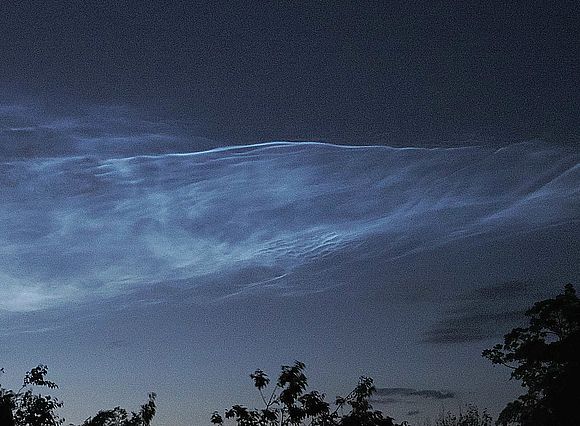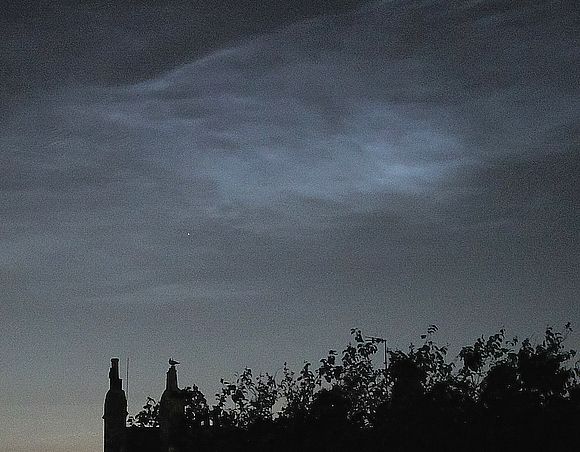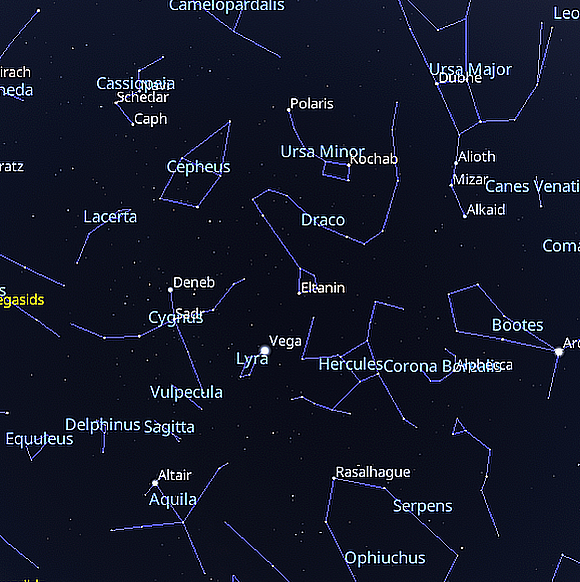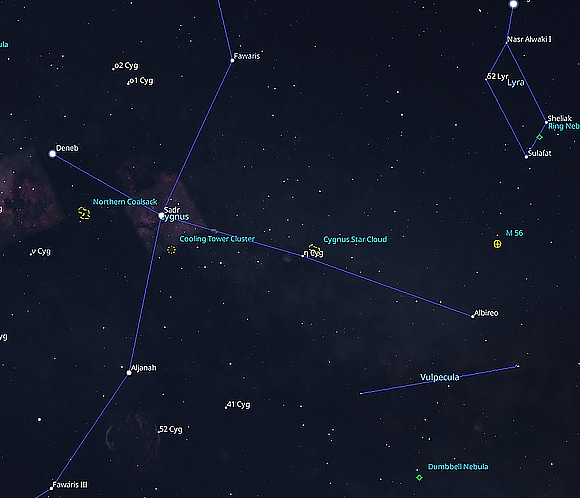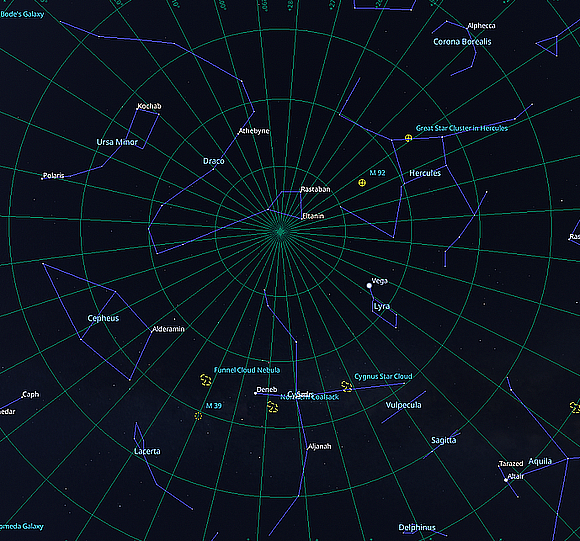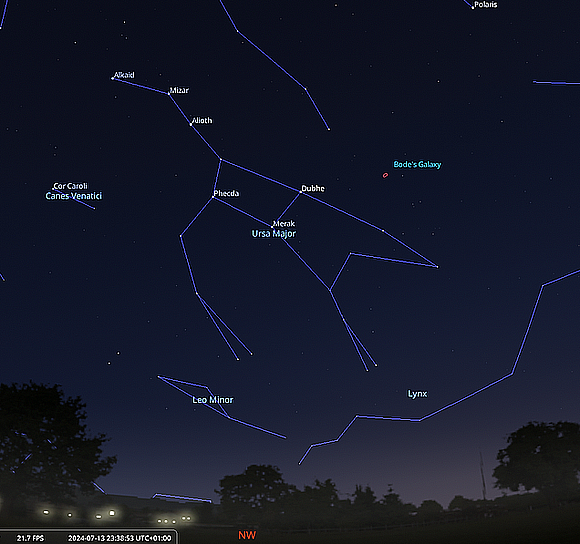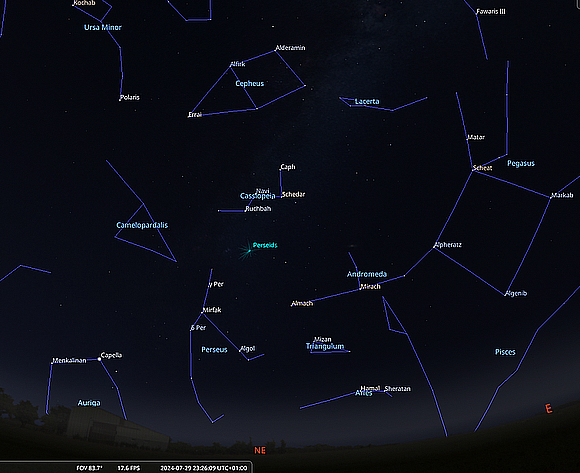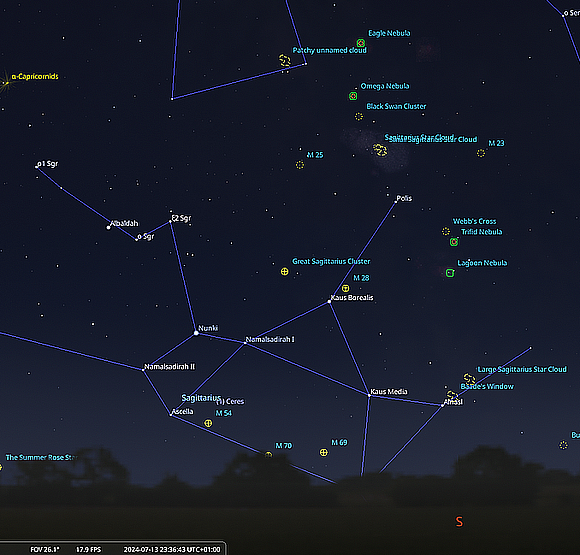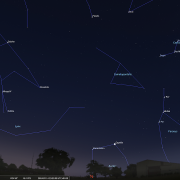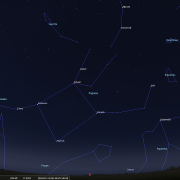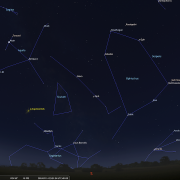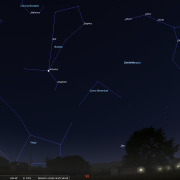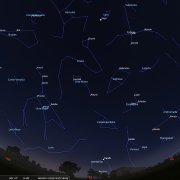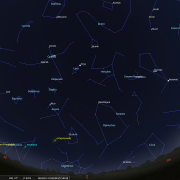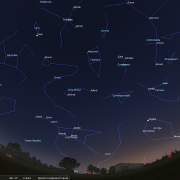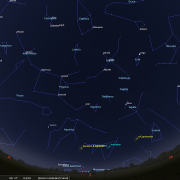In this month's Sky Notes:
- Planetary Skylights.
- July Meteors and Noctilucent cloud reports.
- July Night Sky.
- July 2024 Sky Charts.
Planetary Skylights: A Brief Guide to July's Night Sky
Planetary activity is confined to the early morning sky with three planets visible to the naked eye, and a further two requiring enhanced optical aid. One of these, Uranus, is in close conjunction with Mars mid-month. Jupiter returns to the dawn sky, as Saturn edges toward being a pre-midnight object.
 Saturn continues to make inroads into the early morning sky and from mid-July will be visible just above the ESE horizon by midnight and by 22:45hrs BST by the month's end. Although still not 'observer friendly' hours for many amateur astronomers, the observing window is lengthening all the time - a good 5+ hours by the start of August.
Saturn continues to make inroads into the early morning sky and from mid-July will be visible just above the ESE horizon by midnight and by 22:45hrs BST by the month's end. Although still not 'observer friendly' hours for many amateur astronomers, the observing window is lengthening all the time - a good 5+ hours by the start of August.
When close to the horizon 'seeing' will still be marginal but as Saturn slowly gains in elevation observations will improve somewhat. Anyone expecting to view the glorious ring system may be disappointed to note that the tilt of orientation is little more than 2 degrees. This will increase to 5 degrees later in the year before finally closing at ring plane crossing in March of 2025 when the rings will be practically edge on. On July 25th a waning gibbous Moon lies a few degrees to the left of Saturn.
Neptune can be tracked down with a telescope, a good star chart, and patience. It lies a binocular field left of Saturn but will be challenging.
 Mars is still floundering somewhat in the early morning sky at the start of July, visible in the ENE by 02:00hrs BST. The Red planet will slowly gain elevation as the month progresses, reaching 30 degrees plus by the end of July when skies lighten around 04:00hrs. Mars will then be visible before 01:00hrs BST. Those wanting to scrutinize the tiny disk of Mars, currently less than 6 arc-seconds in diameter, should wait until later in the month by which time Mars will clearing the unstable ‘seeing’ conditions lower down. Even so, very little in the way of features will be visible unless using apertures of over 350mm (14"). To the naked eye, at magnitude +0.9 Mars is roughly comparable in brightness to nearby Aldebaran in Taurus and of similar colour. The waning Moon lies above-right of Mars on July 1st at 03:00hrs BST and the following morning roughly mid-way between Mars and the Pleiades star cluster, with Jupiter lower down.
Mars is still floundering somewhat in the early morning sky at the start of July, visible in the ENE by 02:00hrs BST. The Red planet will slowly gain elevation as the month progresses, reaching 30 degrees plus by the end of July when skies lighten around 04:00hrs. Mars will then be visible before 01:00hrs BST. Those wanting to scrutinize the tiny disk of Mars, currently less than 6 arc-seconds in diameter, should wait until later in the month by which time Mars will clearing the unstable ‘seeing’ conditions lower down. Even so, very little in the way of features will be visible unless using apertures of over 350mm (14"). To the naked eye, at magnitude +0.9 Mars is roughly comparable in brightness to nearby Aldebaran in Taurus and of similar colour. The waning Moon lies above-right of Mars on July 1st at 03:00hrs BST and the following morning roughly mid-way between Mars and the Pleiades star cluster, with Jupiter lower down.
Dedicated planetary observers will be keen to follow a Mars-Uranus conjunction mid-month when Mars passes below Uranus during July 15th & 16th, the pair separated by just over half a degree. Uranus will not be visible to the naked eye but will be seen as a speck in binoculars and a tiny grey/green disk with a telescope. The optimum time to view is between 02:00 - 03:00hrs BST.
The Moon lies in proximity to Mars a second time by the end of July, a waning crescent residing just below the Pleiades and above Mars on the 30th. Also note how Mars and Jupiter have markedly closed together since the start of the month. (See Jupiter)
 Jupiter makes a welcome return to the early morning sky, immediately becoming the most conspicuous planet visible, far outshining Saturn and Mars reaching magnitude -2 by the months end. At the start of July Jupiter will still be rather low and may even be missed if your ENE horizon is poor. Matters improve quickly as we head through July with Jupiter gaining altitude as it follows in the wake of the Hyades star cluster in Taurus, tracking 6 degrees northeast of them by July's end. By then Jupiter will be almost 30 degrees above the east horizon and a viable observing target largely clear of unstable air.
Jupiter makes a welcome return to the early morning sky, immediately becoming the most conspicuous planet visible, far outshining Saturn and Mars reaching magnitude -2 by the months end. At the start of July Jupiter will still be rather low and may even be missed if your ENE horizon is poor. Matters improve quickly as we head through July with Jupiter gaining altitude as it follows in the wake of the Hyades star cluster in Taurus, tracking 6 degrees northeast of them by July's end. By then Jupiter will be almost 30 degrees above the east horizon and a viable observing target largely clear of unstable air.
Through the eyepiece Jupiter's noticeably oblate disk appears a whopping 40 arc seconds in diameter - a pleasing sight even with a small telescope. Look for the banding across the disk, the great red spot may be glimpsed in apertures of 150mm (6") and humble binoculars will reveal the attendant Galilean moons in proximity. Should you be up early morning on July 3rd - 4th around 03:00hrs, look for a slender crescent Moon in conjunction with Jupiter.
On the last morning of the month the Moon once again lies nearby Jupiter but note how much Jupiter and Mars have closed since the Moon last visited them at the start of July. Keep watching as the month changes to August with Jupiter and Mars involved in a spectacular early morning conjunction mid-month.
July Meteors and Noctilucent Cloud
A number of lesser meteor showers occur during July.
The Capri-Cornids have 3 maxima, July 8, 15, and 26, all with zenith hourly rates (ZHR) well short of a dozen, barely more than sporadic rates. Early morning hours will offer the best chance of catching a few shooting stars, which means July 26th will be hampered most by moonlight from a waning gibbous phase. The Moon will have set by midnight on July 15th.
The Alpha Cygnids peak on July 21st, but again rates are barely more than sporadic levels. Cygnus is well placed high in the SSE by midnight; however a Full Moon coincides with this date.
The Delta-Aquarids are a little more prolific, peaking on July 30th with a ZHR of around 15. Moonlight will be minimal.
Noctilucent Cloud Watch
Strong displays of noctilucent cloud had been rather elusive so far this summer with the few sightings very low to the north horizon and not very extensive. That changed during the last week of June with some fine displays reported - and missed by Mark, however on the 28th he did observe a rather unusual display from his home in Whitby between 23:00hrs and midnight. The display was quite confined, relatively high to NNE and according to Mark resembled a 'blue whale' on first sighting. Over the best part of an hour the cloud slowly migrated lower to the north, subtly changing structure, fading as it did so.
The 'Blue whale' noctilucent cloud facing north - June 28th 23:30hrs BST. Image - Mark Dawson - Whitby. (Click for larger image)
The 'Blue whale' noctilucent cloud more detailed June 28th - 23:32hrs BST.
Image - Mark Dawson - Whitby. (Click for larger image)
Noctilucent cloud formations are normally associated with being observed around the midnight hour, which is late enough for most, but Mark had earlier received reports of noctilucent cloud being visible on nights around the solstice, but after 02:30hrs when most people are asleep, Mark for one. Unfortunately, no images were taken, a pity as by accounts the display was very extensive! Unless any members did capture it. The NCL season normally draws to a close by the end of July, so there is still plenty of time to witness a display. Do then remain vigilante!
A close-up of the fading noctilucent cloud migrating lower to the north. The star Capella is visible above the chimney pot seagull.
Image - Mark Dawson - Whitby. (Click for larger image)
There has been auroral activity - but often during daylight hours. The final week of June has seen increased activity according to data, but we have had no confirmed sightings from Whitby. Again, if you can, do keep watch to the north.
July Night Sky
Nights in early July are every bit as light and restrictive as those of June and it's not until the very end of the month before evenings perceptively start to darken again. For those not accustomed to the summer night sky, finding one's celestial barings is not so straightforward given the lingering bright twilight and lack of identifiable constellations before midnight. Here, the brightest summer stars visible come to the rescue to some extent, acting as stellar 'signposts' as dusk settles. Brightest of our summer luminaries, Arcturus can be located high in the SW in the constellation of Boötes, the Herdsman. Once a star not dissimilar to our Sun, Arcturus has reached the evolutionary stage of converting Helium at its core, a process lasting another 200 million years or so. As such Arcturus is the nearest 'orange giant' star to us - just 37 light distant, its distinct orange hue a fine sight in a telescope.
In comparison almost equally brilliant Vega found high overhead to the east appears by its steely blue lustre still in the flush of youth. Appearances can be deceptive though with Vega already halfway through its lifespan, just 500 million years old! This, a consequence of mass, Vega is at least double that of our Sun, so that it will also become an orange giant star, ending its days as a planetary nebula.
Vega is the brightest member of the 'summer triangle', an asterism of three stars including Altair and Deneb, first coined by Sir Patrick Moore in 1957 and now in popular use. Altair in Aquila the Eagle the most southerly of the trio, is closest of the bright summer luminaries visible from UK shores, a mere 16 light years away. Deneb, in the constellation of Cygnus is by far the furthest (1,700 light years) and least brilliant of the trio to the eye, however its true luminosity probably exceeds 150,000 times the Sun's. This will doom Deneb to a short life, and spectacular death, going supernova 20 million years hence!
One of the few popular Chinese tales associated with the night sky absorbed into western culture involves Vega and Altair, the imperial weaver girl and the lowly goat herder. After falling in love, they neglected their duties and so to prevent further interruption to their work the celestial emperor harshly separated them, placing them on opposite sides of the Milky Way. Thereafter, the couple were allowed only to meet one night each summer, the seventh night after the seventh full Moon, when magpies bridged the Milky Way with their wings. In these parts not so sure on magpies, but seagulls would be a good bet!
Returning to Arcturus, look for the delicate circlet of stars marking Corona Borealis - the Northern Crown, located upper left of Boötes. Its chief star, Alphecca or Gemma, is reasonably conspicuous set midway along the starry circlet. To the left of Corona and high to the South, stands a great hero of mythology, Hercules, a large but ill-defined group. The central asterism of Hercules, known as the 'keystone', resembles the shape of the central stone of an arch. On the right-hand side confine of the Keystone resides the wonderful deep sky object M13 - the great globular star cluster, visible in binoculars as a blurred star, but revealed through modest scopes as a glowing gossamer ball containing upwards of half a million stars 26,000 light years distant.
Above Hercules, the head of Draco stands almost overhead, the dragon's body winding down between the two celestial bears. Alpha Draconis or Thuban lies roughly midway between Mizor in the handle of the Plough and Pherkad major and Kochab in Ursa Minor. It is only the 8th brightest star in the constellation, its 'alpha billing' due to the fact 5 thousand or so years ago it was the star nearest the north celestial pole. The effect of precession (earth's axial wobble) has since moved that point to where it stands today - near Polaris in Ursa Minor. This star can be located due North just over halfway up. Utilising the 'pointer stars', Dubhe and Merak, in the 'bowl' of the familiar ‘saucepan’ outline of the Plough, part of Ursa Major - the Great Bear, emerging from her twilight den around 23:15hrs BST. Many 'non astronomers' mistake the bright star low to N horizon at this time of year for the North Star, but Capella in the circumpolar constellation of Auriga - the Charioteer should be considered a winter luminary, and after Arcturus and Vega is the 3rd brightest star visible during the summer months.
Just a short hop to the east from Polaris - midway up from the NNE horizon, the rather faint 'crooked house' outline of King Cepheus holds court. His wife, the more distinct constellation of Queen Cassiopeia is often referred to as the “W” pattern for obvious reasons! When skies become fully darkened again in August, it’s well worth spending time exploring Cassiopeia with optical aid, the constellation containing numerous star fields and clusters. Below Cassiopeia, extending up from the NNE horizon is the great hero Perseus, the pattern of which reminds a little of a distorted Pi symbol reaching up toward Cassiopeia. The Queen's sacrificial daughter - Princess Andromeda, along with the winged horse, Pegasus, accompany Perseus on his journey into the NE sky. Even though we would consider July 'midsummer', these seasonal autumn groups are already champing at the bit to take centre stage.
This seems all too early, as in the opposite direction in the WNW the last vestiges of spring are just departing. Spica, chief star in Virgo doing so shortly after 23:00hrs BST in the WSW. Much of the SW aspect is occupied by the three large figures of Hercules, Ophiuchus and Boötes we have visited in previous months. Just visible above the SSW horizon is the bright fiery hue of Antares, chief star in the constellation of Scorpius, which unfortunately only partly rises from the UK. Following the Scorpion across the S horizon, Sagittarius is best identified by the ‘Teapot’ asterism, sitting almost on the horizon. Again, the bottom part of Sagittarius currently fails to rise over UK shores and it's a pity we don't get to view it higher in the sky, awash as it is with numerous deep sky objects (DSOs). That's not to say observers should stay clear of the Archer, far from it as we shall discover next month when Sagittarius is a little better best placed.
July Sky Charts.
Additional Image Credits:
- Planets and Comets where not otherwise mentioned: NASA
- Sky Charts: Stellarium Software and Starry Night Pro Plus 8
- Log in to post comments

